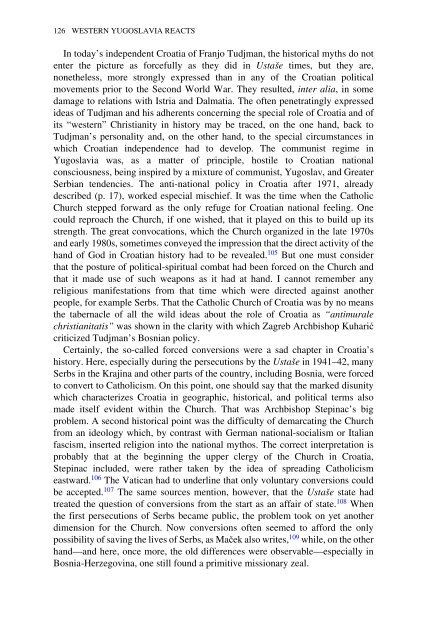Yugoslavia: A History of its Demise - Indymedia
Yugoslavia: A History of its Demise - Indymedia
Yugoslavia: A History of its Demise - Indymedia
You also want an ePaper? Increase the reach of your titles
YUMPU automatically turns print PDFs into web optimized ePapers that Google loves.
126 WESTERN YUGOSLAVIA REACTS<br />
In today’s independent Croatia <strong>of</strong> Franjo Tudjman, the historical myths do not<br />
enter the picture as forcefully as they did in Ustaše times, but they are,<br />
nonetheless, more strongly expressed than in any <strong>of</strong> the Croatian political<br />
movements prior to the Second World War. They resulted, inter alia, in some<br />
damage to relations with Istria and Dalmatia. The <strong>of</strong>ten penetratingly expressed<br />
ideas <strong>of</strong> Tudjman and his adherents concerning the special role <strong>of</strong> Croatia and <strong>of</strong><br />
<strong>its</strong> “western” Christianity in history may be traced, on the one hand, back to<br />
Tudjman’s personality and, on the other hand, to the special circumstances in<br />
which Croatian independence had to develop. The communist regime in<br />
<strong>Yugoslavia</strong> was, as a matter <strong>of</strong> principle, hostile to Croatian national<br />
consciousness, being inspired by a mixture <strong>of</strong> communist, Yugoslav, and Greater<br />
Serbian tendencies. The anti-national policy in Croatia after 1971, already<br />
described (p. 17), worked especial mischief. It was the time when the Catholic<br />
Church stepped forward as the only refuge for Croatian national feeling. One<br />
could reproach the Church, if one wished, that it played on this to build up <strong>its</strong><br />
strength. The great convocations, which the Church organized in the late 1970s<br />
and early 1980s, sometimes conveyed the impression that the direct activity <strong>of</strong> the<br />
hand <strong>of</strong> God in Croatian history had to be revealed. 105 But one must consider<br />
that the posture <strong>of</strong> political-spiritual combat had been forced on the Church and<br />
that it made use <strong>of</strong> such weapons as it had at hand. I cannot remember any<br />
religious manifestations from that time which were directed against another<br />
people, for example Serbs. That the Catholic Church <strong>of</strong> Croatia was by no means<br />
the tabernacle <strong>of</strong> all the wild ideas about the role <strong>of</strong> Croatia as “antimurale<br />
christianitatis” was shown in the clarity with which Zagreb Archbishop Kuharić<br />
criticized Tudjman’s Bosnian policy.<br />
Certainly, the so-called forced conversions were a sad chapter in Croatia’s<br />
history. Here, especially during the persecutions by the Ustaše in 1941–42, many<br />
Serbs in the Krajina and other parts <strong>of</strong> the country, including Bosnia, were forced<br />
to convert to Catholicism. On this point, one should say that the marked disunity<br />
which characterizes Croatia in geographic, historical, and political terms also<br />
made <strong>its</strong>elf evident within the Church. That was Archbishop Stepinac’s big<br />
problem. A second historical point was the difficulty <strong>of</strong> demarcating the Church<br />
from an ideology which, by contrast with German national-socialism or Italian<br />
fascism, inserted religion into the national mythos. The correct interpretation is<br />
probably that at the beginning the upper clergy <strong>of</strong> the Church in Croatia,<br />
Stepinac included, were rather taken by the idea <strong>of</strong> spreading Catholicism<br />
eastward. 106 The Vatican had to underline that only voluntary conversions could<br />
be accepted. 107 The same sources mention, however, that the Ustaše state had<br />
treated the question <strong>of</strong> conversions from the start as an affair <strong>of</strong> state. 108 When<br />
the first persecutions <strong>of</strong> Serbs became public, the problem took on yet another<br />
dimension for the Church. Now conversions <strong>of</strong>ten seemed to afford the only<br />
possibility <strong>of</strong> saving the lives <strong>of</strong> Serbs, as Maček also writes, 109 while, on the other<br />
hand—and here, once more, the old differences were observable—especially in<br />
Bosnia-Herzegovina, one still found a primitive missionary zeal.
















